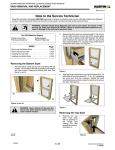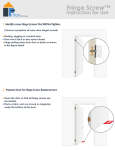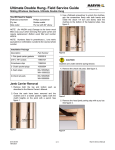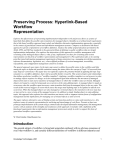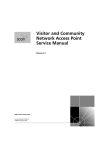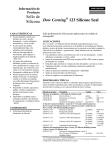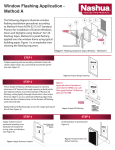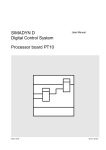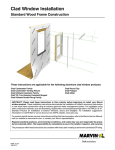Download Window Installation StormPlus and Structural Installation
Transcript
Window Installation StormPlust and Structural Installations These instructions are applicable for the following Structural installations: Clad Ultimate Double Hung Magnum Wood Ultimate Double Hung Magnum These instructions are applicable for the following StormPlus products: Clad Ultimate Casement1 Clad Ultimate Double Hung (CUDH)2 Clad Direct Glaze Polygon/Round Top Clad Ultimate Double Hung Magnum Wood Ultimate Casememt1 Wood Ultimate Double Hung (WUDH)2 Wood Direct Glaze Polygon/Round Top Wood Ultimate Double Hung Magnum NOTE: Certified IZ2 and IZ3 Ultimate Casement, Ultimate Double Hung, and Direct Glaze Polygon/ Round Top units must be installed using jamb screws or structural brackets. Certified IZ3 Ultimate Double Hung Magnum units must be installed using the jamb screw method only. ABSTRACT These instructions advise the window installer/carpenter/contractor on the recommended way to install Marvin windows where structural installation is necessary, including those rated for use in Impact Zones 2 and 3. Exact installation methods for Impact Zone 4 windows are NOT included. Instead, refer to the Notice of Acceptance (see details inside). In addition to steps for installing your window, included within are: Rough opening (RO) preparation for recessed masonry applications; RO prep and sealing details for standard wood frame construction; detailed fastening methods and more. The procedures within these instructions are consistent with those used in testing to achieve the advertised DP rating. Contact your local Marvin dealer if your construction scenario differs from those detailed within. Regional standard practices, environmental conditions and codes may vary and supersede the procedures contained within. The responsibility for compliance is yours: the installer, inspector, and owner(s). See the Technical Installation Specifications inside for more details. 1Includes 2Includes Awning, Operator, Picture 1,, Stationary 3/4,, Round Top Operator, and Round Top Stationary. Picture, Transom, Round Tops and Polygon 19970019 2013−03−01 Table of Contents Page Technical Installation Specifications . . . . . . . . . . . . . . . . . . . . . . . . . . . . . . . . . . . . . . . . . . . . . . . . . . . . . . . . . . . 2 Before You Begin . . . . . . . . . . . . . . . . . . . . . . . . . . . . . . . . . . . . . . . . . . . . . . . . . . . . . . . . . . . . . . . . . . . . . . . . . . . . . 3 Installer and Builder Information, Homeowner Information, and Aftermarket Products Step One − Rough Opening and Framing Requirements . . . . . . . . . . . . . . . . . . . . . . . . . . . . . . . . . . . . . . . . . 4 Concrete Block with Plywood Buck, Concrete Block with 2, Buck or Standard Wood Framing Step Two − Unit Preparation . . . . . . . . . . . . . . . . . . . . . . . . . . . . . . . . . . . . . . . . . . . . . . . . . . . . . . . . . . . . . . . . . . . 6 Packaging, Shipping Blocks, Jamb Extension, Nailing Fin and Wood Brick Mould Casing Step Three − Installing the Window . . . . . . . . . . . . . . . . . . . . . . . . . . . . . . . . . . . . . . . . . . . . . . . . . . . . . . . . . . . . 7 Shimming, Plumbing and Squaring Fastening Methods and Jamb/Sill Screw Chart . . . . . . . . . . . . . . . . . . . . . . . . . . . . . . . . . . . . . . . . . . . . . . . . . 8 Wood Screws/Concrete Anchors and Structural Brackets Special Fastening Systems . . . . . . . . . . . . . . . . . . . . . . . . . . . . . . . . . . . . . . . . . . . . . . . . . . . . . . . . . . . . . . . . . . 10 StormPlus Ultimate Double Hung IZ3 Storm Brackets Step Four − Final Installation Procedures . . . . . . . . . . . . . . . . . . . . . . . . . . . . . . . . . . . . . . . . . . . . . . . . . . . . . 11 Standard Frame Construction and Recessed Masonry Applications. Continuous Air Barrier Systems . . . . . . . . . . . . . . . . . . . . . . . . . . . . . . . . . . . . . . . . . . . . . . . . . . . . . . . . . . . . . . 12 Installation, Integration, and window installation tips for house wrap. Removing Interior Stops, Liners, and Fillers . . . . . . . . . . . . . . . . . . . . . . . . . . . . . . . . . . . . . . . . . . . . . . . . . . . 14 Removing Casement interior stops, Removing Ultimate Double Hung jamb carriers Removing Sash . . . . . . . . . . . . . . . . . . . . . . . . . . . . . . . . . . . . . . . . . . . . . . . . . . . . . . . . . . . . . . . . . . . . . . . . . . . . . 15 Ultimate Double Hung and Ultimate Casement Operators StormPlus IZ4 Notice of Acceptance Information . . . . . . . . . . . . . . . . . . . . . . . . . . . . . . . . . . . . . . . . . . . . . . 16 Warranty Painting and Staining Information 19970019 2013−03−01 1 Window Installation StormPlus and Structural Installations Technical Installation Specifications The following details are specified for proper installation and for the unit to meet the advertised design pressure (DP) rating. S Rough Opening Width: 1/4,−1, (6−25) wider than window/door frame outside measurement. S Properly flash and/or seal all windows at the exterior perimeter. S Sealants used for installation must be Grade NS Class 25 per ASTM C920 and compatible with the building exterior, window exterior surface, and flashing/water management materials. S Flashing materials must comply with ASTM E2112−01, section 5.13 and be compatible with all materials used in installation including panning systems, air barriers and building papers, sheathing, and the window unit. Flashing material must not contain asphalt and must be compatible with flexible PVC (vinyl) when used in conjunction with nailing fin. S Optional foams used for installation must be low expansion only. Foam and foam application must comply with ASTM E2112−01, SEC 5.9.2. S Rough Opening Height: 1/4,−1/2, (6−13) higher than window/door frame outside measurement. S Masonry Opening Width: 1/4,−1/2, (6−13) wider than window/door frame outside measurement. S Masonry Opening Height: 1/8,−1/4, (3−6) higher than window/door frame outside measurement. Architectural Detail Manual Specifications: S Rough Opening:Width 1, (25); Height 1/2, (13). S Masonry Opening:Width 1/2, (13); Height 1/4, (6). S If using less than a nominal 2, x buck in masonry openings; the rough opening must be no more than 1/2,(13) wider and 1/4,(6) taller than the outside measurement of the frame. Installation methods are limited to Jamb Screw method using 3/16, concrete screws. S Shims are required between the window frame and framing members at all locking points and at every point of attachment (excluding nailing fin and brick mould casing) as well as at all points detailed within these instructions. S For units with flat casing install with installation brackets, structural masonry brackets, or jamb screws. S Marvin recommends the use of sloped sills on all concrete openings (either pre−cast or poured). S Do not use chemically treated products for shim material. S Regarding recessed masonry openings: the window frame must not come in direct contact with masonry/concrete/concrete block. Construct framing from treated lumber or plywood and fasten to the masonry opening jambs, header, and sill. This framing must be designed (and anchored to the opening) properly to withstand certified and advertised DP ratings for your particular unit. S Fasteners penetrating chemically treated lumber must be a minimum of 0.90 oz/ft2 zinc hot dipped galvanized or stainless steel type 304 or 316. S Clad window frames must not come into direct contact with chemically treated wood products. S For installations in typical wood frame construction (with sheathing and building paper or air barrier material) where a continuous air barrier system is used, refer to ASTM E2112−01 or reference the “Continuous Air Barrier Systems” section for details on preparing the rough opening and sealing the installation. S For installations in concrete block, or masonry construction, etc., follow local codes for sealing and water management details. Be aware that the use of rigid sill pans and other barriers will decrease the rough opening height clearance. Adjust opening dimensions accordingly. WARNING: Drilling, sawing, sanding or machining wood products generates wood dust, a substance known to the State of California to cause cancer. Avoid inhaling wood dust or use a dust mask or other safeguards for personal protection. California Health and Safety Code Section 25249.6. 19970019 2013−03−01 2 Window Installation StormPlus and Structural Installations Before You Begin Installer and Builder Information S Read these instructions thoroughly BEFORE beginning to install your Marvin window product. S It is the responsibility of the builder, installer and subcontractors to protect the interior and exterior of windows or doors from excessive contact with harsh chemical washes, construction material contamination and moisture. Damage to glazing, hardware, weatherstrip and cladding/wood can occur. Protect with painters tape and/or protective sheathing as required. Follow all guidelines regarding material use, preparation, personal safety and disposal. S Always provide a copy of these instructions for the current or future building owner. S Plan sizing of rough opening and clearance from exterior finishing systems to allow for normal materials shrinkage or shifting (e.g. wood structure with brick veneer, allow adequate clearance at sill). Failure to do so can void the Marvin warranty coverage. S Refer to the enclosed painting and staining instructions on the last page for exterior and interior finish instructions. S Refer to the Technical Installation Specifications section for technical specifications regarding the installation of this product. These installation requirements as well as the details in this section must be followed to achieve the advertised design pressure (DP) rating of this product. S Contact your Marvin supplier if you have any questions regarding product and materials used in manufacturing or questions on replacement parts. Aftermarket Products Alterations to Marvin products including window films, insulating or reflective interior window treatments or additional glazings can cause excessive heat buildup and/or condensation. They may lead to premature failures not covered under warranty by Marvin Windows and Doors. Before purchasing or applying any product that may affect the installation or performance of Marvin windows contact the manufacturer of aftermarket product/glazings that are not supplied by Marvin and request written product use, associated warranties and damage coverage. Provide this information and warranties to the end user and/or building owner for future reference. Hazard Notations Please familiarize yourself with the following hazard notations used throughout this instruction. Caution Warning Seek Assistance Tips/Hints Impact Product Mistakes or misuse could cause damage to the window or result in faulty installation and unit performance. Mistakes or misuse could result in personal injury and/or severe damage to unit, equipment, and/or structure. Help from another individual is necessary to perform this task safely and correctly. Information on alternative procedures, definitions, helpful hints. Steps related to Impact rated products only. Standard Parts Shipped You Will Need to Supply Units are sent with hardware; clad units are sent with four (4) nailing fin corner gaskets. Follow installation instructions included with part if applicable. UDHM units are sent with a fastening package and supplemental installation instructions. Safety glasses Hearing protection Level Square Hammer Wood shims Insulation Tape measure Sill pan flashing Perimeter sealant1 Backing material (foam backing rod) Low expansion foam insulation2 Appropriate fastener (see Jamb/Sill Screw Chart) Construction adhesive3 NOTE: Depending on the installation method, other material may be needed to properly prepare and seal the installation such as self sealing adhesive membrane, building paper, and seam seal tape, etc. NOTE: Numbers listed in parentheses ( ) are metric equivalents in millimeters rounded to the nearest whole number. WARNING: Always practice safety! Wear the appropriate eye, ear and hand protection, especially when working with power tools. 1Sealant must be Grade NS Class 25 per ASTM C920 and compatible with building exterior and window surface. use low expansion foam insulation only. Foam and foam application must comply with ASTM E2112, section 5.9.2. 3APA rated AFG−01 spec 2Optional, 19970019 2013−03−01 3 Window Installation StormPlus and Structural Installations Step 1: Rough Opening and Framing Requirements This section gives requirements for framing and rough opening clearances. Masonry or concrete openings must be lined with a treated wood product (wood buck). You must fasten the buck to the masonry opening in a fashion that will withstand conditions which would be encountered under the certified and advertised DP ratings for this window. The structural integrity of this installation is only as good as the bond between the wood buck and the masonry opening. For more details, contact your Marvin representative. NOTE: Wood buck material thickness may vary. Illustrations show a 1/2, plywood and 2 x 4 buck. Installations using material less than 2, nominal material must use the jamb screw method of attachment and use 3/16, concrete anchors. Treated 2 x 4 buck Construction adhesive (a) Adhesive flashing Masonry anchor 1/2, treated plywood (c) (b) Figure 1: Preparing openings for concrete block openings. 1. On concrete block, masonry, or similar situations, line the sides, head jamb, and sill with treated lumber. Attach the lumber to the masonry opening with construction adhesive and masonry anchors which should penetrate the masonry opening by at least 1,−1 1/2, (25−38). See figure1a and 1b. NOTE: If your installation requires screwing through the sill for structural purposes, place a bead of sealant where the screws will penetrate the rigid sill panning. 4. The window frame must not come in contact with treated lumber. If you will not be using rigid panning or shimming at the sill, apply a barrier such as a self sealing adhesive flashing to the rough opening sill. See figure 1 c. 2. For standard wood frame construction, prepare the opening following local codes, ASTM E2112−1, or follow the steps in the “Continuous Air Barrier Systems” section. 3. If rigid panning is used, place a bead of silicone or construction adhesive over any fasteners used to hold the panning to the sill. 19970019 2013−03−01 4 Window Installation StormPlus and Structural Installations Step 1: Rough Opening and Framing Requirements (cont.) 1/2, 1/4, 1/4, 1/2, Rough Opening Masonry Opening Figure 2: Preparing openings for concrete block openings. 5. Rough openings1 (RO) should be 1, (25) wider than the outside measurement of the frame and 1/2, (13) higher. Masonry openings (MO) should be 1/2, (13) wider than the outside measurement of the frame or casing and 1/4, (6) higher than the outside measurement of the frame or casing. When framing rough opening, care should be taken to ensure the sill plate is level and the opening is square, straight and plumb. See figure 2. ATTENTION: Be aware that use of rigid sill pans and other barriers will decrease the rough opening height clearance. Adjust opening dimensions accordingly. CAUTION! If the previous conditions are not met, the installer must take corrective actions to alter the opening(s) before proceeding. It is also essential that the sheathing behind the wall be a solid surface to ensure that the unit can be secured firmly to the wall. NOTE: On standard wood frame construction with brick veneer, make sure there is at least 1/2, (13) between bottom of window sill (or eventual placement of the window) and the top row of brick to avoid “brick bind”. 1Rough opening gap must be no more than 1/4, for products certified for use in IZ4 regions. 19970019 5 2013−03−01 Window Installation StormPlus and Structural Installations Step 2: Unit Preparation 1. Remove the protective packaging from the unit and dispose/recycle properly. Inspect unit for any hidden damage and report immediately to your Marvin representative. Provide the customer service number etched on one of the top corners of the glass. See figure 3. Customer service number 2. Remove any shipping clips unless noted otherwise. NOTE: Do not remove the vinyl shipping blocks or shipping tube assembly on Ultimate Double Hungs until installation is complete (unless installing with jamb screws). 3. If used on clad units, position the factory applied nailing fin/drip cap in the upright position. See figure 4. 4. On wood units with brick mould casing, apply sealant at the casing to frame joint along the jambs and head jamb, at the sill horn to casing joint, and at the miter corners of the casing. See figure 5. Tool the bead to ensure proper adhesion to both surfaces. Figure 3: 5. If you are installing a window with structural brackets, fasten to the window now. Follow the fastener spacing in the “Jamb/Sill Screw Chart”. Follow the instructions provided with the brackets for details on how to fasten to unit. Ultimate Double Hung Magnum units are sent with supplemental instructions which detail how to remove the sash and jamb fillers. 6. If you will be fastening with screws through the jambs, head jambs, and sill, remove your sash and covers or liners at this time. Refer to the section, “Removing Interior Stops, Liners, and Fillers” and “Removing Sash” for details. Figure 4: Extend nailing fin. 7. Install jamb extension before installing the window in the rough or masonry opening. Follow instructions provided with the jamb extension. Figure 5: Apply back−caulking to BMC. 19970019 2013−03−01 6 Window Installation StormPlus and Structural Installations Step 3: Installing the Window The following steps provide details for structural fastening of the window to the opening. When installing windows with nailing fin or wood brick mould casing, it may be desirable to first attach the window using these fastening methods in conjunction with steps 1−5. Then complete the installation by fastening with structural brackets or screws. Always follow fastener spacing outlined in the “Jamb/Sill Screw Chart” section. On applicable construction using a continuous air barrier system, prepare the opening before installing the window. Refer to the “Continuous Air Barrier Systems” section for details. Measure diagonally for square (b) (a) (c) Figure 6: Plumb and square unit. (Illustration shows both structural bracket and jamb screw installation.) 5. Fasten and shim at the top corners to square the unit in the opening. Take diagonal measurements of the window. When equal, the window is square in the opening. Adjust the shims and fasteners until the unit is square in the opening. See figure 6b. Seek Assistance: Some large windows and/or assemblies are very heavy. Avoid injury by getting help to lift and position the window into the rough opening. CAUTION: Proper shimming is extremely important. Under−shimming or over− shimming will result in bowed jambs and or head jamb. Both conditions can contribute to improper window operation and performance. 1. If rigid sill pan is not used, pan sill with alternate methods or shim under window sill to ensure it does not come in direct contact with treated lumber. 2. On some larger units such as the Ultimate Double Hung Magnum, it may be necessary to remove the sash prior to installation. See the sash removal section for details. Installation Tip: On operating units, one method to ensure that the unit is installed square is to check the reveal (gap) between the operating sash and the frame. An even reveal around the entire sash generally indicates a correctly installed unit and will ensure smooth operation. 3. Center the window in the opening. Level at the sill and plumb the frame (interior/exterior) to desired depth. 4. Fasten and shim the jambs at the bottom with the appropriate fastener (follow instructions in the “Fastening Methods” section). See figure 6a. 6. Complete shimming and fastening at locations and spacing specified in the “Jamb/Sill Screw Chart”. See figure 6c. NOTE: Some units such as the Ultimate Double Hung Magnum and IZ3 Ultimate Double Hung, feature unique fastening systems. For these windows refer to the “Special Fastening Systems” section for details. 7. Recheck the diagonals one more time to make sure the unit is square in the opening. Adjust fasteners as necessary to bring to square. 8. Once the unit is installed square and plumb, operate the sash (on operable units) to make sure it is operating properly. If not, you may have to make some additional adjustments to the shims and fasteners. 9. If removed, replace your stops, covers, and liners. 19970019 2013−03−01 7 Window Installation StormPlus and Structural Installations Fastening Methods and Jamb/Sill Screw Chart Although structural installations may involve fastening with wood brick mould casing or nailing fin, there are two ways to fasten your jambs to the opening for structural purposes: 1. #8 Wood screws (or 3/16, concrete anchors), 6, (152) from all corners and 15, (381) on center around the perimeter. or 2. Structural brackets, 6, (152) from all corners and 15, (381) on center around the perimeter. Refer to the “Jamb/Sill Screw Chart” for proper fastening requirements for your particular product. Illustrations show a concrete block opening but apply to typical wood frame construction as well. NOTE: All mulled units require fastening with two screws or brackets on each side of the mull joint no more than 6, (152) from mull joint. NOTE: Single UDH products do not require fastening at the sill. Multiple wide UDH assemblies require anchoring at the sill mullion. UDHM IZ3 units must be installed with jamb screws, fastening at the sill is not required. Structural Brackets Jamb/Sill Screw Chart 1. Wrap brackets around the framing/buck/opening, fasten with two #8 x 1 5/8, screws. Angle the screws approximately 15 degrees away from the window. Always shim above or behind installation brackets. Shim 1/4, 5/32, holes Screws Jamb Screw Length Sill Screw Length Clad Ultimate Casement Family and Direct Glaze 3, (76) 2 1/2, (64) Wood Ultimate Casement Family and Direct Glaze 3, (76) 3 1/2, (89) Ultimate Double Hung Family 2 1/2, (64) N/A Ultimate Double Hung Magnum Family* Supplied with unit N/A Product * Use predrilled holes in frame members. Jamb/Sill Screws 1. Space fasteners along jambs and head jambs no more than 6, (152) from each corner and 15, (381) on center. Follow same spacing for sills when applicable. NOTE: Structural brackets are allowable replacements for screws if fastening at the sill is necessary. Figure 7 2. After removing covers or liners, fasten units to the framing with #8 wood screws or 3/16, concrete anchors1. Adjust length of fastener so that it penetrates no less than 1 1/4, (32) into framing/opening. When fastening through the sill, always pre−drill and fill hole with sealant before driving the screw. Always place a shim behind or above the screw location on jambs and head jambs. NOTE: When using masonry anchors, be sure to follow manufacturer’s guidelines for proper installation. Some types require pre−drilling. 1Use concrete anchors when wood buck material is less than 2, nominal thickness. 19970019 8 2013−03−01 Window Installation StormPlus and Structural Installations Fastening Methods (cont.) 3. On Ultimate Casement units, position the screw so that it misses any operating hardware (if applicable). With typical installations, you should be able to locate the screw in the center groove in the frame and just to the exterior of the kerf that holds the head jamb stop. See figure 8. 4. On Ultimate Double Hung units, locate the screw in the jamb carrier kerf (jambs) and in the kerf used to hold the parting stop (head jamb). Make sure to countersink the screw so that it doesn’t interfere with installation of the jamb liner and/or parting stop. See figure 9. Fastener Fastener Figure 9: Exterior View, fastening through UDH frames. 5. On IZ3 Ultimate Double Hung units, fasten through the “Storm Brackets” on the jambs with two #8 x 2 1/2, (64) wood screws through the top bracket and one screw through the bottom bracket. See the “Special Fastening Systems” section for more details. Figure 8: Exterior view, fastening through Ultimate Casement frames. 19970019 2013−03−01 9 Window Installation StormPlus and Structural Installations Special Fastening Systems StormPlus Ultimate Double Hung IZ3 Storm Brackets (a) (d) (e) (b) (c) (f) Figure 10: Fastening UDH Storm Brackets. 1. Ultimate Double Hung IZ3 units have two storm brackets attached to each jamb. If you are using the jamb screw method for installation you will notice these when you remove the clad and wood fillers. If you are using the masonry bracket method, you must first remove the check rail dust block and pull out the bottom part of the top jamb weather strip as well as remove the bottom sash stay. See figures 10a and 10b. 2. Push the clad jamb filler up as far as it will go to reveal the predrilled hole in the jamb carrier. Fasten the jambs through the storm bracket by driving one of the #8 x 2 1/2, screws through the pre−drilled hole in the jamb. See figure 10c. 5. Extend storm brackets during inclement weather by inserting a stick pin, nail, or pen through the hole in the bracket. Then slide the bracket away from the window frame as shown in figure 11. Figure 11: Using storm brackets 3. Press the top jamb weatherstrip back into place. Slide the bottom jamb filler down as far as it will go. Fasten the jamb through the storm bracket by driving two of the #8 x 2 1/2, screws through the pre− drilled holes in the jamb. See figure 10d. WARNING: IZ3 storm protection for CUDH operators requires that storm brackets be put in the extended position. If the homeowner will be away from home for any period of time in which strong winds are possible, it is recommended that the storm brackets be pulled out to the extended storm ready position before leaving home. 4. Slide the bottom jamb filler back up until it touches the jamb weatherstrip. Replace the check rail dust block and the bottom sash stay. See figures 10e and 10f. 19970019 2013−03−01 10 Window Installation StormPlus and Structural Installations Step 4: Final Installation Procedures This section does not include details on sealing installations that incorporate a continuous air barrier system such as house wrap or building paper in standard wood frame construction. For flashing details in this application refer to the section, “Continuous Air Barrier Systems − Flashing the Installation”. Sealant Backer rod Sealant (a) (b) (c) Figure 12: Sealing recessed masonry openings 1. Place a bead of sealant at the wood buck to masonry joint. See figure 12a. 3. In some situations such as recessed masonry openings, you can use frame expander or other clad accessories to finish the exterior. If this is the case, apply a bead of sealant between the accessory and the masonry at the head jamb and jamb sections. Leave the sill portion unsealed to allow water to escape. See figure 12c. 2. For recessed masonry applications, Marvin recommends sealing at the buck to frame joint with appropriate width backer rod and sealant around the entire perimeter. Finish as applicable local code dictates. See figure 12b. Low expansion foam Fiberglass insulation Figure 13: Insulating the rough opening 4. Apply a 1,−2, (25−51) thick bead of low expansion foam insulation on the back side of the nailing fin, brick mould casing or other trim. Do not apply too much as it is possible to bow the jambs. Now insulate loosely around the window with fiberglass insulation. See figure 13. 19970019 2013−03−01 5. Interior and mullion trim: Install mullion trim after interior trim or casing is applied. On Ultimate Double Hung units, be sure to use nails and staples that are no longer than 3/4, (19). Place fasteners at least 1, (25) from the edge of interior jamb liner. 11 Window Installation StormPlus and Structural Installations Continuous Air Barrier Systems − Preparing the Opening The method shown below is Method A1 using a TYPE III flash pan. For step by step instructions on how to prepare an opening using this method, refer to www.marvin.com/ROprep for instructions “Window Rough Opening Prep and Flashing Method A1−Membrane Drainage System”. Refer to ASTM E2112−07 for other rough opening preparations that are more appropriate for your situation. Figure 14: Preparing the opening. 19970019 2013−03−01 12 Window Installation StormPlus and Structural Installations Continuous Air Barrier Systems − Flashing the Installation 1. Flash the installation in a weather board fashion. For step by step instructions, refer to www.marvin.com/Roprep for instructions titled “Window Rough Opening Prep and Flashing Method A1−Membrane Drainage System”. Figure 15: Sealing the installation in air barrier applications. Window Flashing Detail (non−recessed masonry) Head jamb flashing Sealant Drip cap Sealant Seam seal tape Jamb flashing Window casing/cladding Siding/ exterior finish Figure 16: Flashing windows with casing in typical wood frame construction (non recessed masonry). NOTE: Figure 16 shows a window with casing but the flashing detail also applies to any clad window product. For installation in typical wood frame construction or brick veneer (non−recessed masonry openings), figure 16 shows the proper flashing detail in shingle style fashion. Once the exterior finish such as siding or brick veneer is installed, a bead of sealant should be applied between the finish and the window/window casing along the sides and approximately 1−2, (25−51) in from the ends at the head jamb (see insert). Use a backer rod when necessary. 19970019 2013−03−01 13 Window Installation StormPlus and Structural Installations Removing Interior Stops, Liners and Fillers Some structural installations that use the “jamb pinning” method require the removal of interior stops before installing the window. This section details the removal of Ultimate Double Hung (UDH) jamb liners and Ultimate Casement operator and stationary stops. Details for UDHM windows can be found in the supplemental instruction sent with the unit. Removing Ultimate Casement Stops and Covers (a) (b) Figure 17: Removing Ultimate Casement stops and covers. 2. Operator jamb covers are held in place by two barbs: one on the interior side and one on the exterior side shared by the frame weather strip. With the sash opened or removed, first pull the frame weather strip out of the kerf and set aside for reuse later. 1. Sill and head jamb covers and stops are held in place with a vinyl barb and can be easily removed by simply and carefully prying up on the stop with a sharp putty knife. Be careful not to damage the stop or frame. Occasionally the barb will stay in the frame when you remove the stop. Remove the barb with a pair of pliers and reinsert into the kerf on the stop/cover. See figure 17a. NOTE: Stationary jamb stops are removed in the same fashion. You will need to remove the head jamb and sill covers first. 3. Remove the sill and head jamb stops. 4. With a sharp putty knife, carefully pry on the interior side between the stop and the frame. Start at one end and work your way down until stop loosens. See figure 17b. Removing UDH Jamb Liners SHOWN FROM EXTERIOR Bottom filler channel Head jamb parting stop (a) (b) (c) (d) (e) Figure 18 1. Remove the head jamb parting stop with use of a pry bar. See figure 18a. 3. From the exterior, pry out the jamb hardware assembly using a pry bar by placing it into the bottom filler channel, hooking it into the notches on the side, and levering it out. See figure 18c. 2. Use a flat headed tool with a 90 degree elbow to remove the lower fillers from the jamb hardware assembly. This is best done by placing the tool into the space opened by the removed checkrail pad. Loosen both corners of the jamb fillers from the notches before trying to remove them, to reduce the possibility of damage to the fillers. See figure 18b. Be sure to take care when doing so, as there is a possibility of the fillers breaking. 4. When installation of the unit is complete, seat the jamb assembly facing towards the exterior first, and ease the remainder of the assembly into the jamb pocket. See figures 18d and 18e. Use of a rubber mallet may be required. If so, take the mallet and, starting at one end, work your way up the filler, until fully seated. (Use of a cloth to protect the wood and keep it clear from direct impact while hammering is suggested.) 5. Reinstall the checkrail pads and head jamb part stop. 19970019 2013−03−01 14 Window Installation StormPlus and Structural Installations Removing Sash Seek Assistance: Some sash on large windows are very heavy. Avoid injury by getting help to lift and position the window into the rough opening. For other products not shown here refer to the Marvin Service Manual or contact your Marvin representative. Ultimate Double Hung Operator Sash (a) (b) (c) (d) Figure 19: Tilting and removing Ultimate Double Hung Sash 1. Raise the bottom sash approximately 4, (102). See figure 19a. 3. Lift both sides of the sash upward 2,−3, (51−76) (raising the pivot pins out of each clutch). See figure 20c. 2. Pull the tilt lever (nested in the sash lock base) until it clicks. Hold the lever until latches clear the unit frame when tilting. Ease top edge of bottom sash out toward you to a horizontal position. See figure 19b. 4. Rotate the sash until the pivot pins clear the jambs and remove the bottom sash from the frame. See figure 19d. 5. Tilt and remove the top sash using the same technique used on the bottom sash. (The top sash uses tilt latches located on both sides of the top rail.) Ultimate Casement Operator Sash Hinge track Operator track extension arm (a) Butterfly clip (b) Hinge arm (c) Pivot shoe (d) Figure 20: Removing Ultimate Casement Operator Sash NOTE: Sash with daylight openings of less than 14 1/2, 2. Disconnect the butterfly clip on the short extension arm from the stud on the sash bracket. See figure 20b. step 2 for these units. 3. Push the sash open to 90 degrees. With a screwdriver or similar tool, pry the bottom hinge off from the stud on the hinge track. Repeat this on the top hinge. See figure 20c. (368) will use hinged single arm operator gear. Skip to 1. Crank open sash until the nylon roller on the long extension arm lines up with the arrow on the operator track. Disconnect the extension arm from the operator track by pushing the roller down through the opening in line with the arrow. See figure 20a. 19970019 2013−03−01 4. Remove the sash by sliding the entire sash on its hinge pivot shoes toward the hinge track studs. The shoes will disengage from the track when they hit the stud. Carefully remove the sash and set aside. See figure 20d. 15 Window Installation StormPlus and Structural Installations IZ4 Notice of Acceptance Exact instructions for installing windows certified for use in Impact Zone 4 are not included in this publication. The installer/contractor MUST install the window(s) according to detailed drawings found in the Notice of Acceptance (NOA) to the Product Control Division of the Miami−Dade County Building Code Compliance Office (BCCO). You will be able to find the NOA drawings for each certified product on the Miami−Dade County website (exact URLs listed below), at www.marvin.com, or you may obtain a hard copy by contacting your Marvin representative. NOA DESCRIPTION URL 07−0524.08 Clad Ultimate Casement Polygon/RT Picture http://www.miamidade.gov/buildingcode/library/productcontrol/noa/07052408.pdf 07−0524.06 Clad Ultimate Casement Operating RT/ Polygon http://www.miamidade.gov/buildingcode/library/productcontrol/noa/07052406.pdf 08−0310.11 Clad Awning http://www.miamidade.gov/buildingcode/library/productcontrol/noa/08031011.pdf 08−0213.08 Clad Ultimate Casement Picture http://www.miamidade.gov/buildingcode/library/productcontrol/noa/08021308.pdf 08−1014.06 Clad Ultimate Casement Operator http://www.miamidade.gov/buildingcode/library/productcontrol/noa/08101406.pdf 08−0310.12 Wood Awning http://www.miamidade.gov/buildingcode/library/productcontrol/noa/08031012.pdf 08−0213.09 Wood Ultimate Casement Picture http://www.miamidade.gov/buildingcode/library/productcontrol/noa/08021309.pdf 08−1014.07 Wood Ultimate Casement Operator http://www.miamidade.gov/buildingcode/library/productcontrol/noa/08101407.pdf 07−0924.01 Clad Direct Glaze Polygon/Round Top http://www.miamidade.gov/buildingcode/library/productcontrol/noa/07092401.pdf 19970019 2013−03−01 16 Window Installation StormPlus and Structural Installations

















